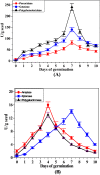Egyptian chia seeds (Salvia hispanica L.) during germination: Upgrading of phenolic profile, antioxidant, antibacterial properties and relevant enzymes activities
- PMID: 34123468
- PMCID: PMC8144251
- DOI: 10.1007/s10068-021-00902-2
Egyptian chia seeds (Salvia hispanica L.) during germination: Upgrading of phenolic profile, antioxidant, antibacterial properties and relevant enzymes activities
Abstract
Little studies on chia sprouts were not deeply address the polyphenols profiles and their functional properties during long period of germination. This study aims to evaluate the impact of germination process on the phenolic profile, antioxidant and antibacterial properties and relevant enzymes activities of Egyptian chia seeds. The total phenolic and flavonoid contents of chia sprouts increased several times during ten days of germination and maximized on 7-day sprouts (6.4 and 11.5 folds, respectively). In HPLC analysis, seventeen phenolic compounds were detected on 7-day sprouts compared to fifteen in dry seeds, where two new phenolic compounds (p-coumaric acid and kaempferol) were detected. The concentrations of all the identified phenolic compounds increased several folds (1.8-27) on 7-day sprouts. The total antioxidant activity increased 10, 17, and 29 folds on 7-day sprouts using DPPH, ABTS and PMC antioxidant methods, respectively compared to the dry seeds. Both antioxidant and carbohydrate-cleaving enzymes increased in chia sprouts and correlated with their phenolic content and antioxidant activity. The phenolic content of 7-day sprouts showed a potent antibacterial activity against some human enteric pathogenic bacteria including Escherichia coli O157-H7, Salmonella typhi, Pseudomonas aeruginosa and Staphylococcus aureus with lower MIC values compared to the raw seeds.
Keywords: Antibacterial activity; Antioxidant activity; Antioxidant enzyme; Carbohydrate-cleaving enzyme; Phenolic content; Salvia hispanica.
© The Korean Society of Food Science and Technology 2021.
Conflict of interest statement
Conflict of interestThe authors have declared no conflicts of interest for this article.
Figures

References
-
- Abdel-Aty AM, Salama WH, Fahmy AS, Mohamed SA. Impact of germination on antioxidant capacity of garden cress: New calculation for determination of total antioxidant activity. Scientia Horticulturae. 2019;246:155–160.
-
- Abdel-Aty AM, Hamed MB, Salama WH, Ali MM, Fahmy AS, Mohamed SA. Ficus carica, Ficus sycomorus and Euphorbia tirucalli latex extracts: Phytochemical screening, antioxidant and cytotoxic properties. Biocatalysis and Agriculture Biotechnology. 2019;20:101199.
-
- Abdel-Aty AM, Salama WH, El-Badry MO, Salah HA, Barakat AZ, Fahmy AS, Mohamed SA. Purification and characterization of peroxidases from garden cress sprouts and their roles in lignification and removal of phenol and p-chlorophenol. Journal of Food Biochemistry. 2021;45:e13526. - PubMed
-
- Abdel-Aty AM, Salama WH, Hamed MB, Fahmy AS, Mohamed SA. Phenolic-antioxidant capacity of mango seed kernels: therapeutic effect against viper venoms. Revista Brasileira de Farmacognosia. 2018;28:594–601.
-
- Adefegha SA, Oboh G, Ejakpovi II, Oyeleye SI. Antioxidant and anti-diabetic effects of gallic and protocatechuic acids: a structure–function perspective. Comparative Clinical Pathology. 2015;24:1579–1585.
LinkOut - more resources
Full Text Sources
